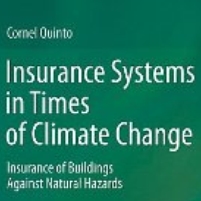Insurers Prepare for Climate Change…Except in U.S.
Sunday, April 29, 2012
 (book by Cornel Quinto)
(book by Cornel Quinto)
Insurance company executives are aware of the future risks posed by climate change. And yet they have been slow to prepare for the coming wave of weather-related accidents and litigation spawned by global warming changes.
In a survey conducted by Ceres, a Boston-based coalition of investors and environmental groups, more than 75% of insurers acknowledged the existence of perils stemming from climate change.
“Yet despite widespread recognition of the effects climate change will likely have on extreme events, few insurers were able to articulate a coherent plan to manage the risks and opportunities associated with climate change,” the Ceres report states.
The Ceres study found that out of 88 U.S. insurance companies, only 11 had formal climate change risk policies and more than 60% had no dedicated management approach to assessing climate risks.
Ben Schiller at Yale’s Environment 360 noted that while American insurance companies have been slow to prepare for global warming’s ramifications, their European counterparts have been getting ready for a potentially costly future.
“It is frustrating to see that it’s so extremely difficult to include this huge risk of climate change into current business,” Andreas Spiegel, senior climate change adviser at Swiss Re, a large reinsurance company, told Schiller. “There is a bit of a short-term view on the benefits, risks, and costs.”
Those companies that have approached the issue have tended to concentrate on the increase in powerful hurricanes while ignoring “non-coastal extreme weather” such as floods, droughts, snowstorms, hailstorms and tornadoes.
Industry observers also anticipate an increase in lawsuits in which communities, businesses and individuals sue polluters for causing that climate change. Among such cases the most notable are Kivalina v. ExxonMobil Corporation, in which the residents of an Alaskan village are suing the oil giant for flooding caused by warming temperatures, and State of Connecticut v. American Electric Power, in which eight states and New York City sued the five largest emitters of greenhouse gases (American Electric Power, Southern Company, TVA, Xcel Energy and Cinergy Corp.).
Of the 11 insurers that do have climate change policies, the Ceres report praised Allianz Group and ACE USA for having the most comprehensive.
-Noel Brinkerhoff, David Wallechinsky
To Learn More:
Insurance Companies Face Increased Risks from Warming (by Ben Schiller, Environment 360)
Climate Risk Disclosure By Insurers: Evaluating Insurer Responses to the NAIC Climate Disclosure Survey (by Sharlene Leurig, Ceres) (pdf)
- Top Stories
- Unusual News
- Where is the Money Going?
- Controversies
- U.S. and the World
- Appointments and Resignations
- Latest News
- Trump to Stop Deportations If…
- Trump Denounces World Series
- What If China Invaded the United States?
- Donald Trump Has a Mental Health Problem and It Has a Name
- Trump Goes on Renaming Frenzy






Comments